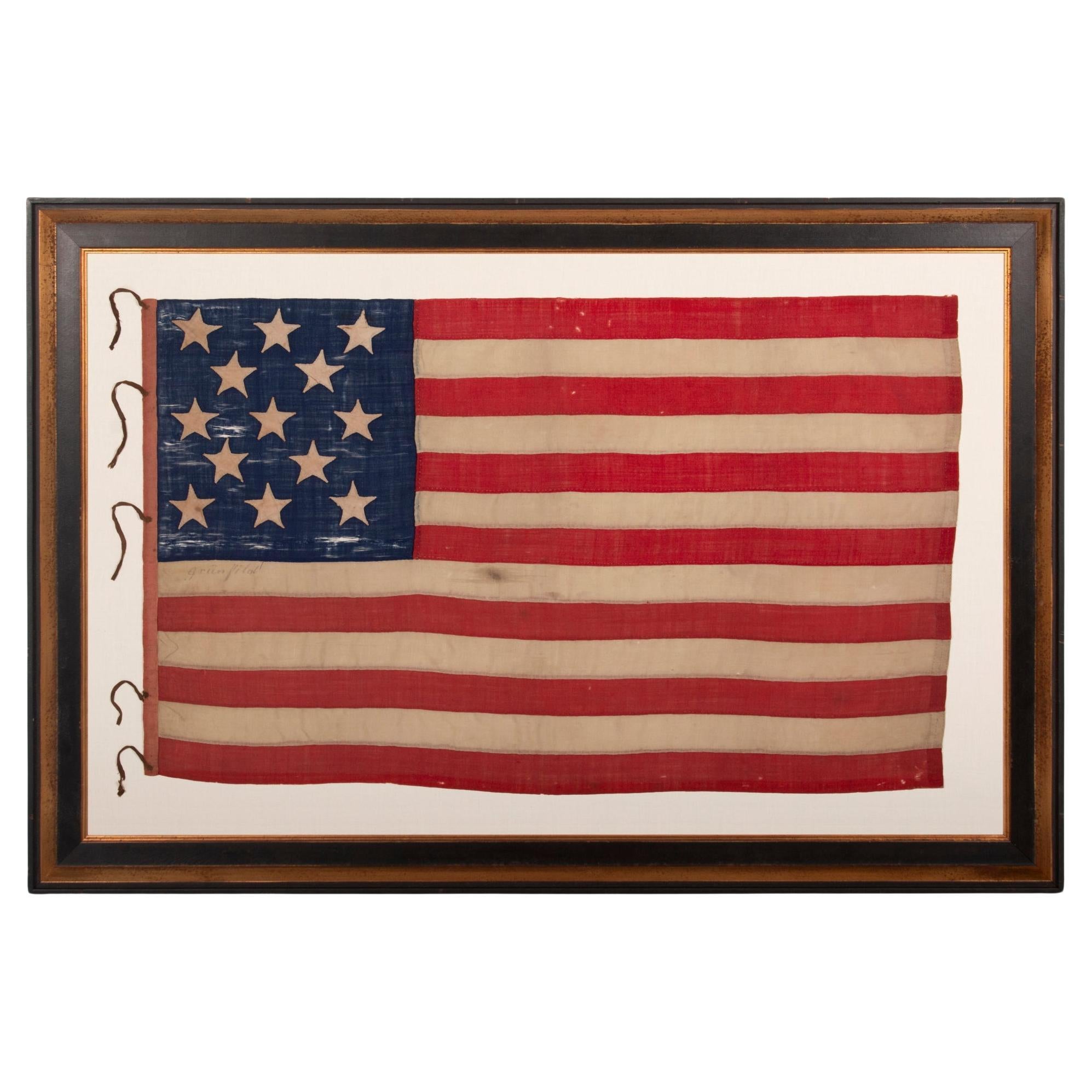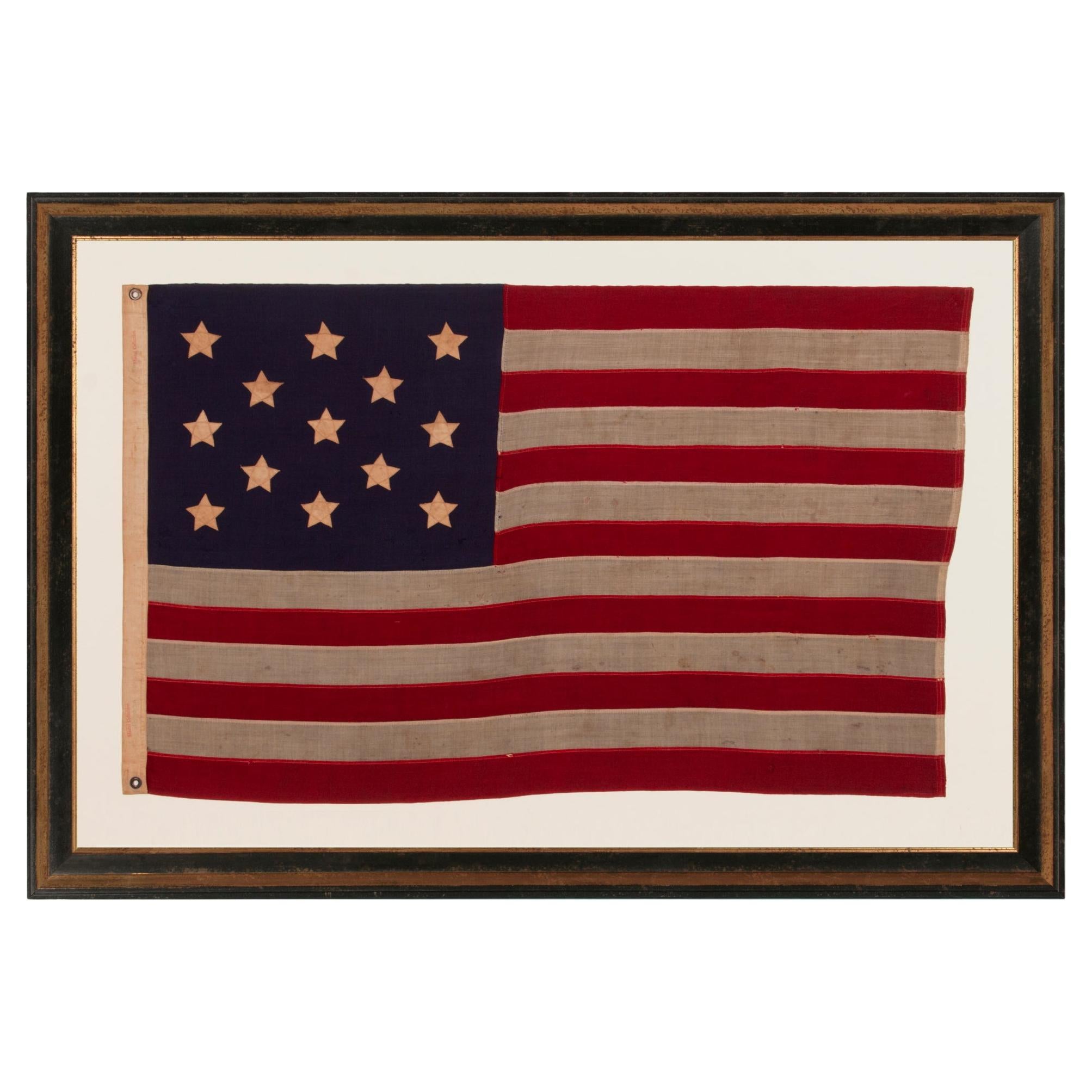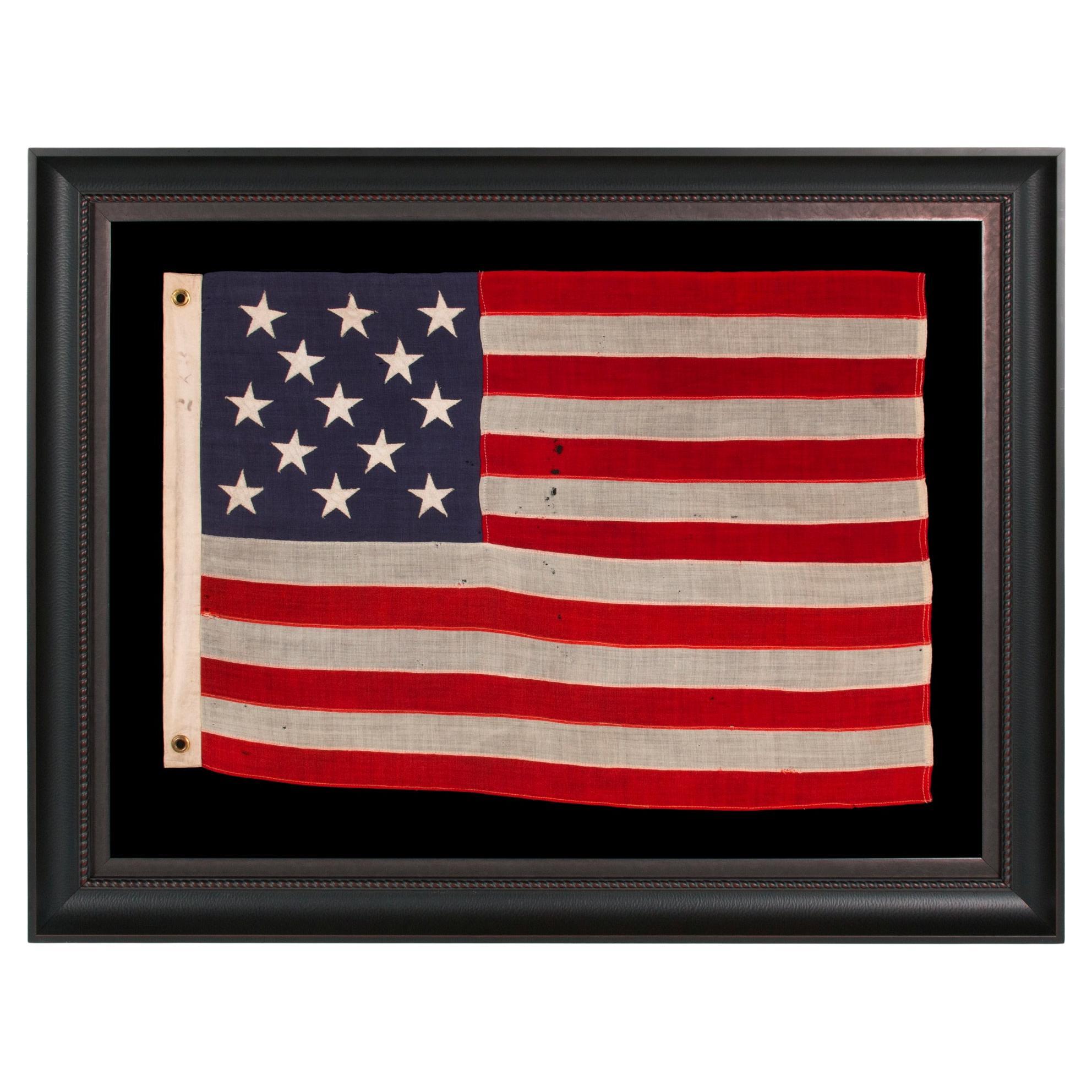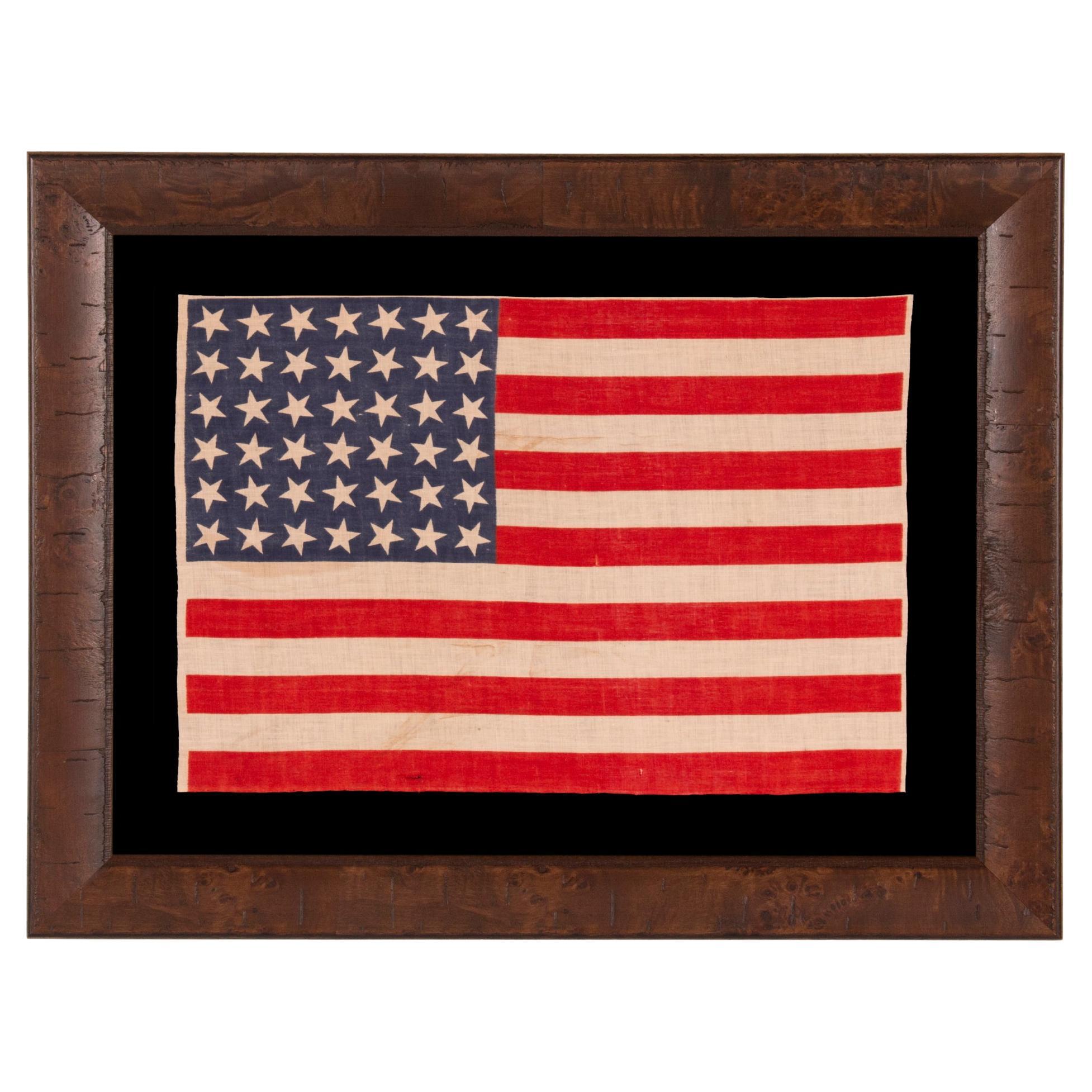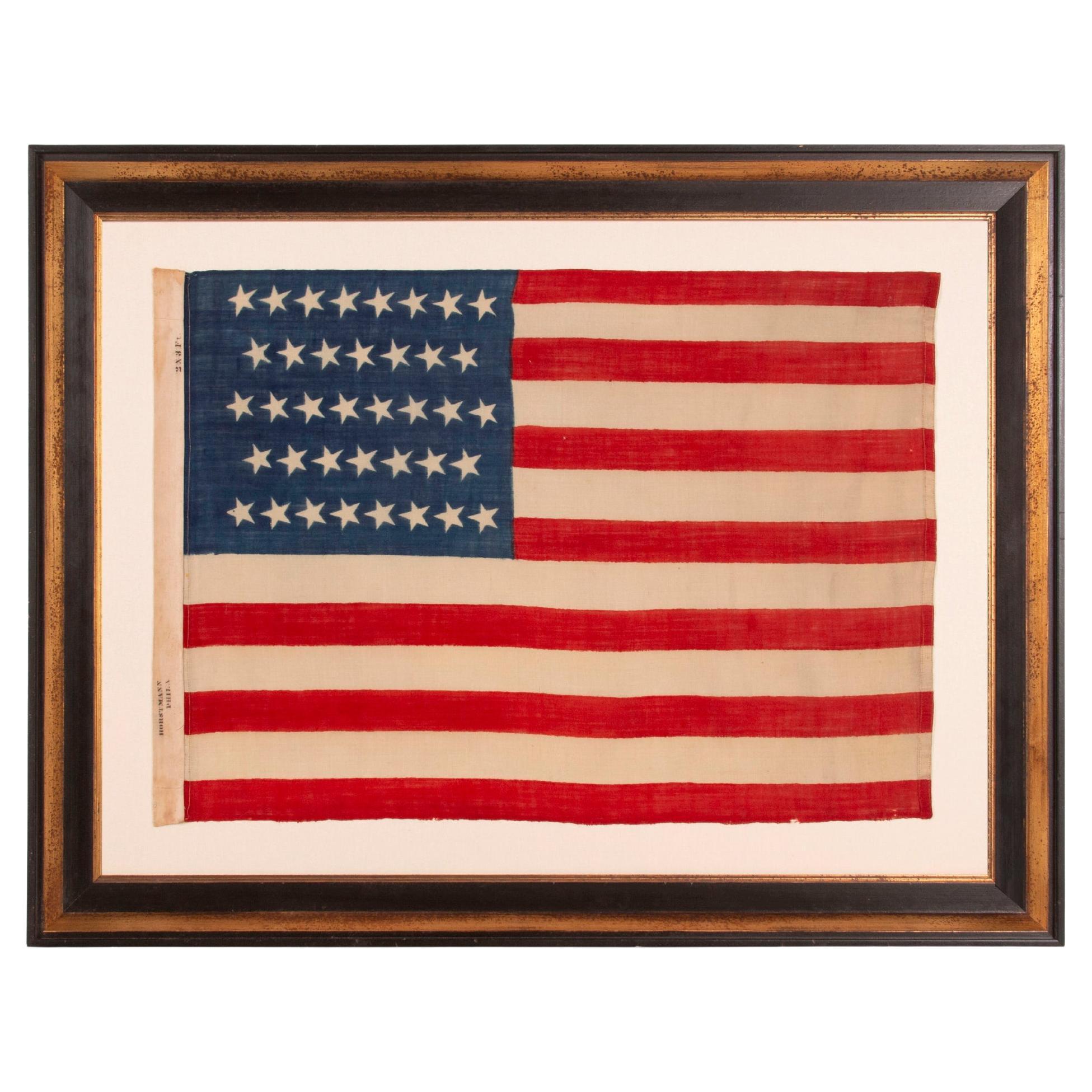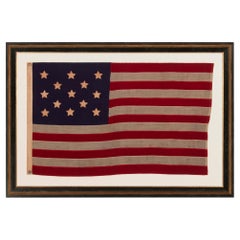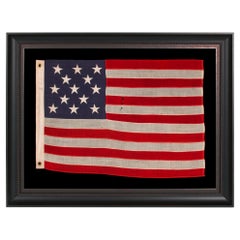
35 Star, Single Appliqued American Flag Signed by a Surgeon, Dr. LP Putnam
View Similar Items
Want more images or videos?
Request additional images or videos from the seller
1 of 7
35 Star, Single Appliqued American Flag Signed by a Surgeon, Dr. LP Putnam
About the Item
- Dimensions:Height: 73 in (185.42 cm)Width: 117 in (297.18 cm)Depth: 1 in (2.54 cm)
- Place of Origin:
- Period:
- Date of Manufacture:1863-1865
- Condition:See Item Descripton.
- Seller Location:York County, PA
- Reference Number:Seller: 35j-8741stDibs: LU84972976542
About the Seller
5.0
Recognized Seller
These prestigious sellers are industry leaders and represent the highest echelon for item quality and design.
Established in 1991
1stDibs seller since 2008
61 sales on 1stDibs
Typical response time: 10 hours
More From This SellerView All
- Hand-Sewn 13 Star American Flag, Signed Grunfild, ca 1861-1877Located in York County, PAENTIRELY HAND-SEWN ANTIQUE AMERICAN FLAG OF THE CIVIL WAR ERA, WITH 13 SINGLE-APPLIQUÉD STARS IN A 3-2-3-2-3 CONFIGURATION, IN A GREAT, SMALL SCALE AMONG ITS COUNTERPARTS, PROBABLY MADE IN NEW YORK CITY, SIGNED “GRÜNFILD” 13 star flags have been flown throughout our nation’s history for a variety of purposes. They were hoisted at patriotic events, including Lafayette’s final visit in 1824-25, the celebration of the centennial of American independence in 1876, and the sesquicentennial in 1926. They were displayed during the Civil War, to reference past struggles for American liberty and victory over oppression, and were used by 19th century politicians while campaigning for the same reason. As the number of stars grew with the addition of new states, it became more and more difficult to fit their full complement on a small flag. The stars would, by necessity, have to become smaller, which made it more and more difficult to view them from a distance as individual objects. The fear was that too many of them close together would become as one white mass and distort the ability to identify American ships on the open seas. Keeping the count low allowed for better visibility. For this reason the U.S. Navy flew 13 star flags on small boats. Some private ship owners mirrored this practice and flew 13 star flags during the same period as the Navy. Flag experts disagree about precisely when the Navy began to revert to 13 stars and other low counts. Some feel that the use of 13 star flags never stopped, which seems to be supported by depictions of ships in period artwork. This was, of course, the original number of stars on the first American national flag, by way of the First Flag Act of 1777, and equal to the number of original colonies that became states. Since there was no official star configuration until the 20th century (1912 specifically, beginning with the 48 star count), the stars on 13 star flags may appear in any one of a host of configurations. Made during the Civil War era, or shortly thereafter, the stars of this particular 13 star flag are arranged in a 3-2-3-2-3 pattern of lineal rows. This configuration appears to have been adopted by the Navy sometime toward war’s end, probably between 1864 and 1865. Afterwards it becomes the most common design across all known styles, for the balance of the 19th century through the first quarter of the 20th. Entirely hand-sewn, the stripes and canton of the flag are made of wool bunting. Note in particular the square profile of the canton, which makes it visually different from modern flags. The stars are made of cotton and are single-appliquéd. This means that they were applied to one side of the canton, then the blue fabric was cut from behind each star, folded over, and under-hemmed, so that one star could be viewed on both sides. I always find single-appliquéd stars more interesting, not only because they are evidence of a more difficult level of seam-work and stitching, but also because they are more visually intriguing. The two visible rows of hand-stitching emphasize their hand-sewn construction. This is one reason why single-appliquéd stars appeal to connoisseurs of early American textiles. While some flag enthusiasts have pointed to this as a means of conserving fabric, not having to cut and sew another star to the opposite side, others suggest that the real purpose was to make the flag lighter in weight. I believe it to have been a byproduct of both objectives. A length of faded, red, herringbone, twill cotton tape was stitched along the hoist end for reinforcement, in lieu of a more formal binding. To this, six lengths of cotton knit shoelace were added (one now absent) as a means of affixing the flag to a staff. This is generally the accepted method for a flag that is to be hand-carried. The cloth tape and ties both add substantially to the flag’s visual presentation. The name “Grünfild” was at some point hand-inscribed beneath the canton. It was common to mark flags in this fashion, during the 19th and early 20th centuries, to indicate ownership. An unusual name in America at this time, I believe that this likely belonged to the only man by this name that is recording as having served during the Civil War. Born around 1843, Morris Grünfild [a.k.a. Grünfield / Greenfield / Grünfildt] emigrated to the United States from Eastern Europe in 1854. A merchant tailor, who I believe may have been of Russian Jewish descent, he records himself as having been born in “Poland / Rus,” but may have moved to Austria in the interim, before traveling to the States. In May of 1861, Grünfild enlisted with the 31st New York Volunteer Infantry, at the rank of Private, in New York City, and was assigned to “C” Company. He served two years, mustering out in New York on June 4th, 1863. Around 1877, Grünfild joined Frank Head Post #16 of the New York State Grand Army of the Republic. The GAR was the primary veteran’s organization for the Union Army. He married a Russian woman from Philadelphia, had many children, and continued to work as a tailor into the 20th century, possibly selling both his services and clothes. Presuming that it was this Morris Grünfild who owned and marked the flag, it is hard to be sure just how he came into possession of it. The construction is actually typical of flags produced in New York, during this time frame and after, by the Annin Company. Known for single-appliqued stars, and for hand-sewing the stripes of smaller flags in particular, as well as for simply producing more, small, sewn flags than their competitors, the flag closely approximates signed, Annin-made examples that I have previously owned. It may, of course, be that Grünfild acquired the necessary bunting at the wharf and sewed the flag in the same fashion as Annin, but I don’t think so. I do, however, believe that it was he who added the herringbone tape and shoelace ties to a flag probably of Annin manufacture. It’s possible that the 31st NY Regiment used the flag as a flank marker or as camp colors. Though a little large in scale for either when compared to military regulations, the flag is small enough to have served effectively in either function. This unit appears not to have turned any colors in to the state at the war’s end, so likely they were taken home. The role that Grünfild played as a private in C Company is unknown. As a tailor, it’s conceivable that he may have played a role in the care or upkeep of flags, but no further information is available. The 31st NY was a very active unit. Recruited from Williamsburg (just over the Brooklyn Bridge) and Manhattan, it had several nicknames, including the “Montezuma Regiment,” “Baxter Light...Category
Antique Late 19th Century American Political and Patriotic Memorabilia
MaterialsCotton
Price Upon Request - 13 Star Antique American Flag , Ca 1890-1899Located in York County, PA13 STARS WITH SHORT, CONICAL ARMS ON A SMALL SCALE, ANTIQUE AMERICAN FLAG MADE DURING THE LAST DECADE F THE 19TH CENTURY; POSSIBLY OF PHILADELPHIA ORIGIN; FORMERLY IN THE COLLECTION ...Category
Antique 1890s American Political and Patriotic Memorabilia
MaterialsWool
Price Upon Request - 13 Star Antique American Flag, ca 1895-1926Located in York County, PA13 STAR ANTIQUE AMERICAN FLAG WITH A 3-2-3-2-3 CONFIGURATION OF STARS ON AN INDIGO CANTON, SQUARISH PROPORTIONS, AND A BEAUTIFUL OVERALL PRESENTATION, MADE circa 1895-1926 This 13 s...Category
Antique Late 19th Century American Political and Patriotic Memorabilia
MaterialsWool
Price Upon Request - 42 Star Antique American Parade Flag, Ca 1889-1890Located in York County, PA42 STARS ON AN ANTIQUE AMERICAN FLAG WITH SCATTERED STAR POSITIONING, REFLECTS THE ADDITION OF WASHINGTON STATE, MONTANA, AND THE DAKOTAS, NEVER AN OFFICIAL STAR COUNT, circa 1889-18...Category
Antique Late 19th Century American Political and Patriotic Memorabilia
MaterialsCotton
Price Upon Request - 39 Star Antique American Flag, Dakota Territories, ca 1876Located in York County, PA39 STARS IN TWO SIZES, ALTERNATING FROM ONE COLUMN TO THE NEXT, ON AN ANTIQUE AMERICAN PARADE FLAG DATING TO THE 1876 CENTENNIAL, NEVER AN OFFICIAL STAR COUNT,...Category
Antique 1870s American Political and Patriotic Memorabilia
MaterialsCotton
Price Upon Request - 36 Star American Flag, Civil War Era, Nevada StatehoodLocated in York County, PA36 Stars In The "Great Star" Or "Great Luminary" Pattern On A Civil War Era Flag With A Dusty Blue Canton And A Section Of One Stripe Souvenired, 1864-67, Nevada Statehood 36 star American national flag of the Civil War era, entirely hand-sewn and with some rare and beautiful features. The stars are arranged in a rendition of what is known as the Great Star or Great Luminary configuration, a large star made out of smaller stars. With no official star pattern before 1912, their design was left up to the artistic liberties of the flag-maker. Strikingly visual, the Great Star is both scarce and coveted by collectors. The 36th state, Nevada, entered the Union during the Civil War on October 31st, 1864. The last Confederate general surrendered on May 26th, 1865. The 36 star flag became official on July 4th of that year, but makers of printed flags would have begun adding a 36th star to their flags in 1864, even before the addition of the new state occurred. Lincoln pushed Nevada through just 8 days before the November election. Nevada’s wealth in silver was attractive to a nation struggling with the debts of war and increased support for the Republican ticket. The 36 star flag was replaced by the 37 star flag in 1867, with the addition of Nebraska. Adding to the flag's appeal is its small scale across those with of piece-and-sewn construction. During the 19th century, sewn flags (as opposed to those that were printed on cloth) were typically eight feet long and larger. This is because they were important in their function as signals, meaning that they needed to be seen and recognized from great distance. A flag that was six feet in length was considered small and production of flags smaller than this was extremely limited. Even infantry battle flags were approximately six by six and-one-half feet, about the size of an average quilt of the same period. As time passed, circumstances changed and sewn flags began to find more of a decorative purpose. Smaller flags are more scarce and far easier to frame and display. The Great Star configuration appears to have come about shortly after the War of 1812, when Congressman Peter Wendover of New York requested that Captain Samuel Reid, a War of 1812 naval hero, create a new design that would become the third official format of the Stars & Stripes. A recipient of the Congressional Medal of Honor, Reid became harbor master of New York following the war. During his lifetime, he created many innovations in signal use, including a system that could actually send messages from New York to New Orleans by sea in just two hours. Use as a Naval signal had been the primary reason for the initial creation of an American national flag in 1777, but since there was no official star design, the appearance of our flag varied greatly. Reid’s primary concern centered on both consistency and ease of recognition. His hope was as more and more states joined the Union and more and more stars were added to the flag, that it would remain easily identified on the open seas. In 1818, Reid suggested to Congress that the number of stripes permanently return to 13 (reduced from 15) and that the stars be grouped into the shape of one large star. Reid’s proposal would have kept the star constellation in roughly the same format, in a pattern that could be quickly identified through a spyglass as the number of states grew. His concept for the stripes was ultimately accepted, but his advice on the star pattern was rejected by President James Monroe, due to the increased cost of arranging the stars in what would become known as the “Great Star”, “Great Flower”, or “Great Luminary” pattern. Monroe probably didn’t wish to impose this cost on either the government or civilians, so he suggested a simple pattern of justified rows. Never-the-less, the Great Star was produced by anyone willing to make it and its rarity today, along with its beauty, has driven the desirability of American flags with this configuration. The canton and stripes of the flag are made of fine merino wool. Note how the canton has faded to a dusty seafoam blue, which is endearingly attractive. The stars of the flag are hand-sewn and single-appliquéd. This means that they were applied to one side of the canton, then the blue fabric was cut from behind each star, folded over, and under-hemmed, so that one star could be viewed on both sides of the flag. I always find single-appliquéd stars more interesting, not only because they are evidence of a more difficult level of seam-work and stitching, but also because they are more visually intriguing. The two visible rows of hand-stitching emphasize their hand-sewn construction, which is one reason why flags with single-appliquéd stars often appeal to connoisseurs of early American textiles...Category
Antique 1860s American Political and Patriotic Memorabilia
MaterialsWool
Price Upon Request
You May Also Like
- 46-Star American Flag Printed in Drum Star ConfigurationLocated in Colorado Springs, COThis is an original 46-Star American parade flag, celebrating Oklahoma statehood. Each star on the flag's canton represents a state in the Union at the time. The official flag design would update every July 4th, to include any new states added to the Union in the past year. Oklahoma, the 46th state, entered the Union on November 16, 1907. As such, this 46–star flag was the official flag of the United States from July 4, 1908, until July 4, 1912. The silk flag has a dark blue canton with 46 white printed stars. The stars are printed in an 7-8-8-8-8-7 row configuration, or “Drum design.” The flag design is completed with 13 alternating red and white stripes, each stripe representing one of the original thirteen colonies. The land that comprises Oklahoma today was added to the United States as part of the Louisiana Purchase of 1803. Throughout the 19th century, the U.S. government relocated Indian tribes from the southeastern United States to the area, and by 1900, over 30 Indian tribes had been moved to what was originally called the Indian Territories. At the same time, ranchers in Texas began to move into the area in search of new pasture lands. Although stipulations in the Indian Relocation Act agreed that the land would forever be Indian Territory, the promise of fertile farmland trumped the government’s promise of sovereignty. On April 22, 1889, they opened the land to settlement by homesteaders, creating a land run in which settlers, called “Boomers,” were allowed to cross the Texas or Arkansas border at a particular hour to claim homesteads. Settlers who illegally crossed the border earlier to stake prime land were called “sooners,” which eventually became the state’s nickname. Wagons and the Santa Fe railroad carried cartloads of men and women to blank town sites and building plots, creating ten thousand-people communities in a matter of days. The following year, the region was further divided into Indian Territory and Oklahoma Territory...Category
Vintage 1910s American Political and Patriotic Memorabilia
MaterialsSilk
- 39-Star Antique American Flag with 'Whimsical' Star Pattern, 1889Located in Colorado Springs, COThis is a 39-star unofficial American flag, handmade and printed on cotton. The flag dates to 1889 and has a unique history, thanks to its rare star-count. The flag’s canton is prin...Category
Antique 1880s American Political and Patriotic Memorabilia
MaterialsCotton
- 36-Star Printed American Flag, Rare Haloed Star Medallion, Circa 1865Located in Colorado Springs, COThis 36-star flag has stars arranged in a gorgeous and highly desirable medallion pattern. This particular medallion includes a large haloed star in the middle, two rings of stars s...Category
Antique 1860s American Political and Patriotic Memorabilia
MaterialsFabric
- 34-Star Civil War American Flag, Antique Great Star Pattern, circa 1861Located in Colorado Springs, COThe stars of this extremely rare, Civil War-era flag are arranged in what is sometimes called the "Great Flower" pattern, a large star made out of smaller stars -- named as such beca...Category
Antique 1860s American Political and Patriotic Memorabilia
MaterialsLinen
$15,500 Sale Price37% Off - 31-Star Printed American Flag, Celebrating California Statehood, Circa 1850Located in Colorado Springs, COThis is a rare 31-star medallion printed American flag, celebrating the addition of California to the Union. The flag is printed on silk and has a spectacular “Great Star” canton pat...Category
Antique 1850s American Political and Patriotic Memorabilia
MaterialsSilk
- 1889 North Dakota 39 Star United States of America Statehood FlagLocated in Coeur d'Alene, ID39 star silk statehood flag. 23 1/2" x 15". Was the unofficial North Dakota Flag. As South Dakota was also admitted as the 40th state on the same day this...Category
Antique 1880s American Historical Memorabilia
MaterialsSilk
Recently Viewed
View AllMore Ways To Browse
Blue Apothecary Bottles
Distressed Debt
Flag Pole With Eagle
Folk Art Felt Pennant
Stars And Bars Confederate Flag
Framed American Folk Art
Antique American Flag 49 Stars
Chinese Porcelain Lunch Box
Vintage Statute
Pennant Banner
Prints Men In Confederate Uniform
Carved Wood Bears
Civil War Cannon Balls
E H Rigg
Japanes Bb V
Leo Cherne
Tar Bucket
Vintage 50 Star American Flag
